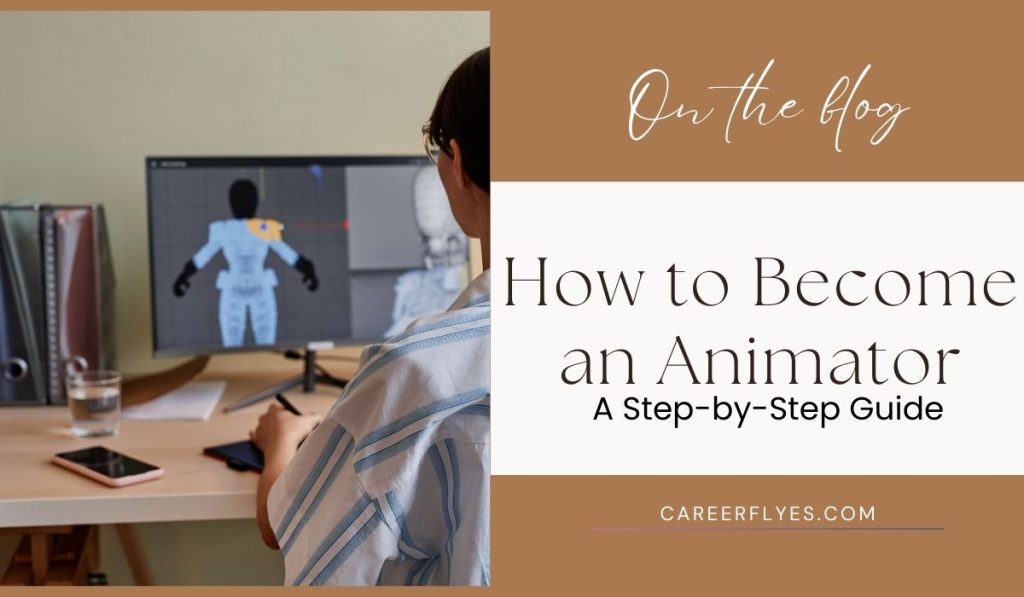How to Become an Animator: A Step-by-Step Guide
6 min read
Animation brings stories to life, allowing you to transform ideas into visual experiences that capture attention and emotion. Whether you are interested in creating films, video games, or advertisements, becoming an animator requires mastering both artistic and technical skills. This guide will help you understand the steps needed to become a professional animator, breaking them down so you can start your journey today.
What is Animator?
Becoming an animator is more than learning software; it’s about mastering the art of storytelling through movement. Animation can take many forms, each with its own style and workflow:
- 2D Animation: Hand-drawn or digitally created, where each frame is illustrated.
- 3D Animation: Models are created and animated using advanced software, giving more depth and realism.
- Stop-Motion Animation: Real-world objects are physically manipulated and filmed frame by frame to create motion.
- Motion Graphics: Primarily used in advertising and corporate videos, this type animates text and objects.
Animation is about bringing characters and scenes to life. It is important to understand the differences in these animation styles to choose the one that fits your passion.
For those interested in building a career in a different field, such as administration, you can explore how to become a district magistrate or IPS officer.
How to Become an Animator

1. Develop Artistic Skills
No matter which animation path you choose, having a solid foundation in art will help you greatly. Drawing helps you visualize characters, environments, and movement more clearly. Even in digital animation, drawing skills are essential.
- Sketch Daily: Set aside time each day to practice sketching characters, objects, and backgrounds.
- Learn Anatomy: Understanding human and animal anatomy is crucial when animating characters. This knowledge will make your characters’ movements more realistic.
- Study Perspective: Learn how to draw objects in 3D space to give your animation depth and believability.
Practice makes perfect. Take life drawing classes or participate in online art challenges to sharpen your skills. Strong drawing abilities make the transition to digital tools smoother.
If you’re still deciding which educational path to take after school, you might want to explore the best courses after 10th to find the right fit for your career goals.
2. Master the Principles of Animation
Before you dive into software, it’s essential to understand the 12 Principles of Animation, which form the foundation of all animations:
- Squash and Stretch: Adds weight and flexibility to objects, whether it’s a bouncing ball or a character’s facial expressions.
- Anticipation: Prepares the viewer for major actions, helping create smoother transitions.
- Staging: Directs the viewer’s attention to the most important element of the scene.
- Follow-Through and Overlapping Action: Ensures that parts of a character or object continue moving after the main action has stopped.
Learning these principles will help your animations feel more realistic and engaging. These concepts apply across all forms of animation, making them a fundamental part of any animator’s skill set.
For other professions requiring precision and artistic skills, like becoming an architect, these foundations of careful planning and execution are essential.
3. Learn Animation Software
With your artistic skills and foundational knowledge in place, the next step is mastering the software that animators use daily. The software you need will depend on the type of animation you are most interested in:
- For 2D Animation: Adobe Animate and Toon Boom Harmony are industry standards for hand-drawn or digital animation.
- For 3D Animation: Autodesk Maya, Blender, and Cinema 4D are the top programs used by professional 3D animators.
- For Stop Motion: Dragonframe and Stop Motion Studio are excellent choices for capturing physical objects frame by frame.
These programs offer vast tools and possibilities. Mastering any of these requires time, practice, and patience, but once you learn them, you’ll be equipped with the skills that studios and production houses are looking for.
If you are considering a broader career in fields like becoming a pilot, learning technical software and tools is essential in these fields as well.
4. Decide on Your Specialization
Animation is a broad field, and as you learn more, you’ll need to decide which area you want to specialize in. Some animators focus on character animation, while others are more interested in visual effects or motion graphics. Think about what excites you most and focus your efforts there.
- 2D Animation: You may want to focus on character creation and storytelling in animated shows or movies.
- 3D Animation: If you love the idea of creating detailed models and realistic scenes, 3D animation might be the path for you.
- Stop-Motion: If you enjoy working with physical objects and have patience for frame-by-frame work, stop-motion is worth exploring.
Once you have chosen your specialization, focus on refining your skills in that area.
5. Build a Strong Portfolio
Your portfolio is your calling card as an animator. It shows studios and employers what you’re capable of and helps them decide whether to hire you. To build an impressive portfolio:
- Focus on Quality: Showcase your best work. A few high-quality pieces are better than a large collection of average work.
- Diversity is Key: Include different types of animation, such as character animation, environmental design, and short clips. This will demonstrate your versatility.
- Show Your Process: Sometimes employers like to see sketches or rough drafts to understand how you think and work through problems.
A strong portfolio should highlight your best work, your creativity, and your technical skills. Keep improving and updating it as you grow as an animator.
6. Practice Regularly
There’s no shortcut to becoming a great animator—it takes regular practice. Working on personal projects, collaborating with other animators, or even participating in online animation challenges are great ways to keep improving.
- Set Daily or Weekly Goals: Commit to working on small animation exercises regularly.
- Join Online Communities: Connect with other animators, share your work, and get feedback on forums or social media groups.
The more you practice, the better you’ll get. Over time, you’ll find that animations that once took hours can be completed much faster as your skills improve.
7. Gain Experience and Build Connections
Experience is crucial in the animation industry. Seek out internships, freelance work, or collaboration opportunities to get hands-on experience:
- Internships: Apply for internships at animation studios to gain industry experience and connections.
- Freelance Projects: Take on small freelance gigs to build your portfolio and earn practical experience.
- Networking: Attend animation festivals, conferences, or online meetups to build connections with industry professionals.
Building relationships with others in the industry will help you find more job opportunities and learn from experienced animators.
For more insights on career paths that involve gaining practical experience and building connections, read about how to become a collector.
8. Keep Learning and Stay Updated
Animation is a rapidly evolving field, with new software, techniques, and trends emerging all the time. As an animator, it’s crucial to stay updated:
- Attend Workshops and Online Courses: Take advantage of online resources, including platforms like Coursera, Udemy, and Skillshare, to learn new skills and stay current with industry standards.
- Follow Industry News: Stay updated with the latest trends in animation, including the use of new tools and methods.
Continual learning is the key to staying relevant in the animation industry. The more you know, the more competitive you’ll be.
Conclusion
Animation is a blend of art, storytelling, and technology. By following these steps, from developing your artistic skills to mastering animation software and building an impressive portfolio, you can turn your creative ideas into a rewarding career. Remember, becoming an animator takes practice, persistence, and passion. Every project you work on brings you closer to success.
Now, begin your journey—animate your dreams into reality!





